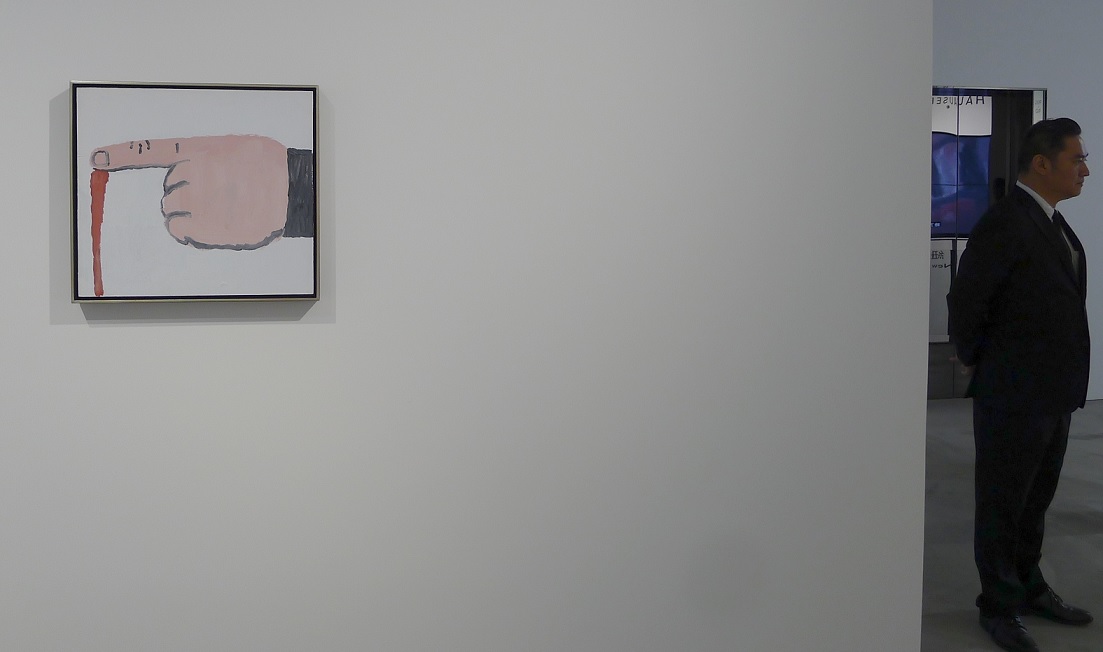新/另類藝術空間
- 大館宇宙中兩種量度方法 | Two Measures of Our Universe
約翰百德 (John BATTEN)
at 5:04pm on 24th August 2018

圖片說明 Captions:
1.《無題》,菲利普.加斯頓(1969)丙烯板上,45.7x50.8厘米,攝於香港豪瑟沃斯畫廊,作品旁為保安員 Philip Guston, Untitled, 1969, acrylic on panel, 45.7x50.8cm, with security guard at Hauser & Wirth Hong Kong
2.《量度宇宙》,Roman Ondák(2018),大館美術館,兩組裝置的圖片 Roman Ondák, Measuring the Universe at Tai Kwun galleries, two installation images, 2018
3. Installation image of Wong Wai Yin & Kwan Sheung Chi’s Everything Goes Wrong for the Poor Couple, Tai Kwun, 2018
All photos: John Batten
(Please scroll down for English version)
香港現正舉行兩場展期尚餘數天的重要展覽會,很值得我們參觀。新開幕的大館美術館揭幕展覽《拆棚》,展出了22位藝術家或藝術家團體的作品。另一個展覽在豪瑟沃斯畫廊舉行,是美國藝術家菲利普.加斯頓(1913-1980)的代表作品展,參觀者可在此欣賞這位影響深遠藝術家多幅甚少在亞洲展出的作品。
《拆棚》策展人李綺敏透過展覽突顯大館內新開美術館的特點。她所選出及展示的作品,可說在挑戰展館的空間。特別是樓底6米高的頂樓展館,是展覽難以善用的空間。當中兩個位於角落的展館可說特別小巧珍貴:它們面積不大但容易管理,而且在實體上與相鄰的較大型展館分隔。其中一個角落展館展出了斯洛伐克藝術家Roman Ondák的《量度宇宙》(2007)。這是一個為展覽場地而設的裝置和表演,需要參觀者參與量高,然後把高度紀錄於展館牆上。近觀,可以清楚看到每位參觀者的名字和到訪日期;遠看,所有字都圍繞著牆壁聚在一起,以抽象化的形態時而向上、時而向下地迴旋。作品就如命題一樣,令人感到它正在刻畫另一個類似銀河世界,一個遙遠的宇宙。然而這個宇宙是由藝術家的量資料建構而成,因為空間永遠都是由我們這些似乎被困在地球的人類來量度。
香港(已婚)藝術家夫婦黃慧妍和關尚智的《貧賤夫妻百事哀》則是最先於2010年現場演出的作品。在展覽中,我們可以看到長達30小時的錄影片段,來自兩位藝術家的原有表演,不斷展示他們10秒一節地重複演出的黑白粵語電影的悲劇場面。這些場面關乎婚姻中尖銳而個人的事件:丈夫在妻子小產後給予苦悶的安慰;又或妻子向丈夫交代婚後情後痛苦、死寂的時刻。原演出為期五天,並在一間細小房間中上演,然後透過視頻連接在相鄰的小房間放映,任由路過的觀眾觀賞。
《拆棚》中所看到的所有藝術品均刻意地反映大館的前身身份:一個監獄、一個被圍封起來的空間、一個紀律嚴謹的地方,現在已開放予公眾。據李綺敏提說,這些藝術「……深沉地反思了……日常存在的那些或隱或現的構造……」
菲利普.加斯頓最先以其於1930年代完成的大型敘事式壁畫打出名堂。在1950年代和1960年代初,追隨著紐約當時的潮流,他演變成一位備受尊崇的抽象藝術家,Mark Rothko和Willem de Kooning都是他的良朋。1968年,加斯頓徹底放下了抽象風格,回歸具象化的繪畫,最初選色只限紅、白、黑。在很多人引用的述句中,加斯頓解釋說:「 60年代來臨,我處於一種精神分裂的狀態。美國所發生的(越戰)戰事,世上的種種暴虐。我算什麼,居然坐在家裡讀雜誌,我對一切都感到沮喪而憤怒 –– 然後能做的就只是回到工作室把紅色調成藍色?」
加斯頓的畫回歸具象化描繪,展現出平凡的日常物品:釘子、靴、工具、書本、鐘、電燈泡和香煙,並附以一連串主題:藝術家躺在床上、戴上兜帽的白人至上主義團體三K黨的人物,桌面上擺放著各種各樣的物件。他刻劃了自己的人生,還有他周圍(似乎精神分裂、不健全)的世界。他的畫作和裡面所反映的近似經典風格人物,都由簡約的室內建築圍繞,明顯是受加斯頓非常欣賞的意大利藝術家Giorgio de Chirico作品影響。加斯頓1968後的畫作以強烈簡約為特徵,至今仍然富有當 代感,歷久彌新和對抗感,令人驚訝。
展覽小冊子引述他1980年其中一個最後的訪問,加斯頓被問及他是否「喜歡奇幻」。他回答道:「奇幻?不,我並不這麼認為。我喜歡那些根植於真實世界的東西。我喜歡老東西,比如重力或是我們行走時位移的方式。我曾經橫躺在一張公園的長椅上,看過往的行人,心裡在想,位移是多麼的奇妙呀。如果『奇幻』意味著對想像的過份使用,那麼我便不喜歡它。不管怎麼說,所有藝術都可算得上是某種幻覺,某種需要努力實現的幻覺。又或者說,是睜著眼睛做夢。」
參考資料:
大館《拆棚》,展期至2018年8月18日止
菲利普.加斯頓的作品於香港豪瑟沃斯畫廊展出,展期至2018年8月25日止
https://www.taikwun.hk/en/exhibition/detail/dismantling%20the%20scaffold/2
https://www.hauserwirth.com/hauser-wirth-exhibitions/14522-philip-guston-a-painters-forms
Two Measures of Our Universe
by John Batten
There are two essential art exhibitions to visit in Hong Kong before they finish in a few days’ time. Dismantling the Scaffold is the inaugural exhibition at the new Tai Kwun galleries featuring 22 artists or artist groups. And, at Hauser & Wirth an exemplary exhibition of American artist Philip Guston (1913-1980) is an opportunity to view a range of this influential artist’s work, rarely exhibited in Asia.
Curator Christina Li puts the new Tai Kwun galleries through their paces in Dismantling the Scaffold. She has selected and displayed a range of work that tests all the gallery spaces; in particular, the top floor gallery with its 6 metre high ceiling is a tough space in which to exhibit. There are two small corner galleries that are gems: they are compact, manageable and physically separated from the larger adjacent galleries. In one of the corner galleries, Slovak artist Roman Ondák’s Measuring the Universe (2007) is a site-specific installation and performance that requires visitor’s heights to be measured and recorded on the gallery wall. Seen close, the names of individual visitors and the date they visited the exhibition can be clearly read, but seen from afar, the text merges and swirls in abstracted patterns up and down and around the walls. It literally feels like the depiction of another world, a Milky Way of sorts, a universe far away, but constructed by the artist’s height measurements, as space is always measured by us who live, seemingly trapped, on Earth.
Hong Kong artist (and married) couple Wong Wai Yin and Kwan Sheung Chi’s Everything Goes Wrong for the Poor Couple is a work originally performed live in 2010. In the exhibition, we see 30-hours of video footage from the original performance with the two artists acting-out, in constantly repeated 10-second loops, different melodramatic scenes from old Cantonese black and white movies. The scenes are of poignant, personal, marital incidents: the anguished comfort the husband gives to his wife after her miscarriage; or, the pained silent moments after the wife revealed to her husband of an affair. The original performances ran over five days and were acted out in a small room which was beamed live through a video connection into an adjacent small room and watched by a passing audience.
All the artwork seen in Dismantling the Scaffold purposely reflects on aspects of Tai Kwun as a former prison, a sealed enclosed place, a place of rigid discipline, which is now open to the public. The art, as Christina Li says, “…offer(s) poignant reflections of the invisible and visible structures that constitute our daily existence….”
Philip Guston first gained prominence with large narrative mural paintings he completed in the 1930s. In the 1950s and early 1960s, and following New York trends of the time, he evolved into a respected abstract artist whose friends included Mark Rothko and Willem de Kooning. In 1968, Guston entirely abandoned abstraction and returned to figurative painting, initially using a limited colour palette of red, white and black. In a much-quoted statement, Guston explained that, “When the 1960s came along I was feeling split, schizophrenic. The (Vietnam) war, what was happening to America, the brutality of the world. What kind of man am I, sitting at home, reading magazines, going into frustrated fury about everything – and then going into my studio to adjust a red to a blue?”
Returning to figurative depiction, Guston’s paintings showed mundane objects: nails, boots, tools, books, clocks, light bulbs and cigarettes, alongside an array of motifs: the artist lying on his bed, hooded white-supremacist Klu Klux Klan figures, a laid-out array of objects on a table. He depicted his life and the (seemingly schizoid, dysfunctional) world around him. His paintings and the near-classical figures within them are surrounded by a pared-down interior architecture, certainly influenced by the work of the Italian Giorgio de Chirico, an artist Guston greatly admired. Guston’s post-1968 paintings, characterized by their strong simplicity, remain surprising contemporary, timeless and confronting.
In one of his final interviews (1980) quoted in the exhibition booklet, Guston is asked if he “loves the fantastic.” He replies, “Fantastic? No, I don’t think so. I like things rooted in the tangible world. I like old-fashioned things like gravity, how we locomote when we walk. I used to lie sideways on a park bench and watch how people walk. I used to think how amazing it is, the locomotion. I don’t like fantastic when it means an overlabored use of the imagination. Anyway, all art is a kind of hallucination, but hallucination with work. Or dreaming with your eyes open.”
Link for further info:
Dismantling the Scaffold at Tai Kwun until 18 August 2018
Philip Guston at Hauser & Wirth Hong Kong until 25 August 2018
https://www.taikwun.hk/en/exhibition/detail/dismantling%20the%20scaffold/2
https://www.hauserwirth.com/hauser-wirth-exhibitions/14522-philip-guston-a-painters-forms
This article was originally published in Ming Pao Weekly on 18 Aug 2018 and translated by Aulina Chan.
